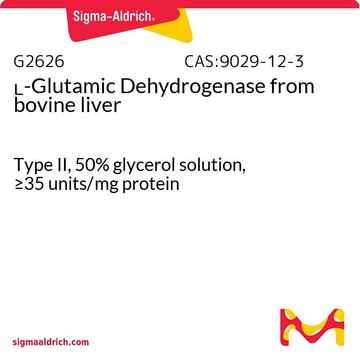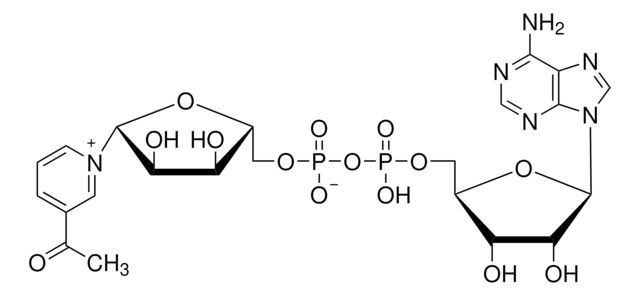MAK099
Glutamate Dehydrogenase (GDH) Activity Assay Kit
sufficient for 100 colorimetric tests
Sign Into View Organizational & Contract Pricing
All Photos(3)
About This Item
UNSPSC Code:
12161503
NACRES:
NA.84
Recommended Products
usage
sufficient for 100 colorimetric tests
detection method
colorimetric
relevant disease(s)
cancer; gastrointestinal diseases
storage temp.
−20°C
Gene Information
human ... GLUD1(2746) , GLUD2(2747)
mouse ... GLUD1(14661)
rat ... GLUD1(24399)
General description
Glutamate Dehydrogenase (GDH) is a mitochondrial enzyme that catalyzes the reversible oxidative deamination of glutamate to α-ketoglutarate and serves as a key link between anabolic and catabolic pathways. In mammals, GDH is subject to allosteric regulation and has high activity in liver, kidney, brain, and pancreas. GDH activity in serum can be used to differentiate between liver diseases due to liver inflammation, which do not show elevated serum GDH activity, and diseases that result in hepatocyte necrosis, which results in elevated serum GDH.
Application
Glutamate Dehydrogenase (GDH) Activity Assay Kit has been used to determine the enzymatic activity of glutamate dehydrogenase.
Features and Benefits
Compatible with high-throughput handling systems.
Suitability
Suitable for detecting glutamate dehydrogenase (GDH) activity in serum or tissue and cell extracts.
Principle
GDH activity is determined by a coupled enzyme assay in which glutamate is consumed by GDH generating NADH, which reacts with a probe generating a colorimetric (450 nm) product proportional to the GDH activity present. One unit of GDH is the amount of enzyme that will generate 1.0 μmole of NADH per minute at pH 7.6 at 37 °C.
replaced by
Product No.
Description
Pricing
Storage Class Code
10 - Combustible liquids
Certificates of Analysis (COA)
Search for Certificates of Analysis (COA) by entering the products Lot/Batch Number. Lot and Batch Numbers can be found on a product’s label following the words ‘Lot’ or ‘Batch’.
Already Own This Product?
Find documentation for the products that you have recently purchased in the Document Library.
Customers Also Viewed
Inactivation of Lsd1 triggers senescence in trophoblast stem cells by induction of Sirt4.
Castex J, et al.
Cell Death & Disease, 8(2), e2631-e2631 (2017)
Is liver enzyme release really associated with cell necrosis induced by oxidant stress?.
Contreras-Zentella M L and Hernandez-Mu?oz R
Oxidative Medicine and Cellular Longevity, 2016 (2016)
The glutamate dehydrogenase pathway and its roles in cell and tissue biology in health and disease.
Plaitakis A, et al.
Biology, 6(1), 11-11 (2017)
Tongxin Wang et al.
Animal nutrition (Zhongguo xu mu shou yi xue hui), 4(3), 329-337 (2018-09-04)
The liver is the most essential organ for the metabolism of ammonia, in where most of ammonia is removed by urea and glutamine synthesis. Regulated by leucine, glutamate dehydrogenase (GDH) catalyzes the reversible inter-conversion of glutamate to ammonia. To determine
L-leucine stimulates glutamate dehydrogenase activity and glutamate synthesis by regulating mTORC1/SIRT4 pathway in pig liver.
Wang T, et al.
Animal Nutrition (2017)
Our team of scientists has experience in all areas of research including Life Science, Material Science, Chemical Synthesis, Chromatography, Analytical and many others.
Contact Technical Service





